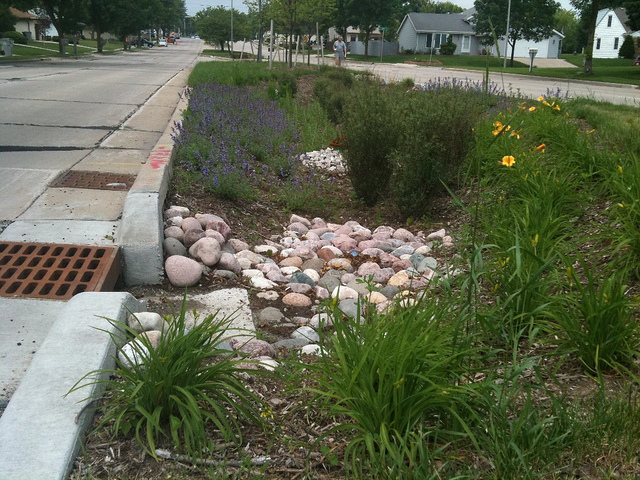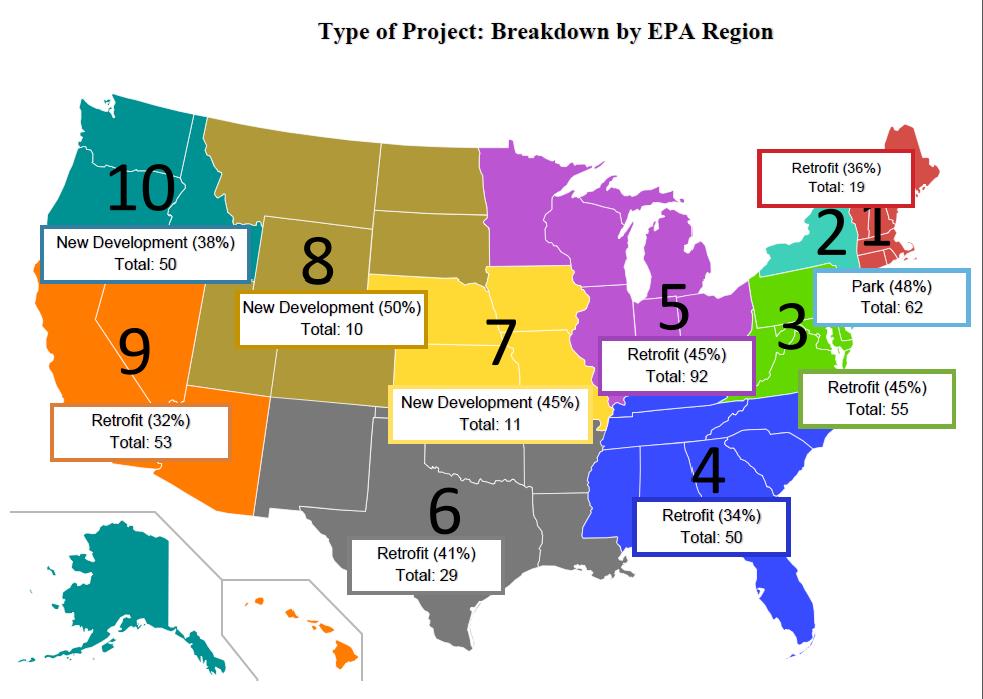“We all live downstream.” In the world of stormwater management, this concept is particularly relevant. Polluted waterways have far-reaching impacts for us all. Increased flooding, higher water treatment costs, strain on existing infrastructure, beach closures, and decreased biodiversity all pose significant and costly threats to communities, towns, cities, and states.
Green Infrastructure (GI), an alternative to traditional urban growth designs, is receiving considerable attention as a cost-effective way to reduce pollution, manage stormwater runoff, improve water quality, and maximize infrastructure investments. GI is an affordable mitigation strategy that uses a variety of techniques, such as native vegetation, rain gardens, bioswales, or porous pavement, to add unique aesthetic value to new or revitalized development site. The EFC’s comprehensive catalog of over 50 GI publications highlights several cities that are leading the country through their use of innovative, comprehensive, and effective GI strategies.
However, outside of these featured case studies, GI projects remain largely piecemeal and single-scale. Further, the EFC’s review of GI literature reveals that there is a perception among many local communities that GI technologies are still emerging and lack a prescriptive framework, and that they can be cost-prohibitive when compared to the traditional pipe and treatment design.
With these concerns in mind, many communities interested in GI are left wondering, “What might a Green Infrastructure project look like in this community?”
To help answer this question and to begin to identify national trends in GI projects, we analyzed a dataset of 431 successfully implemented GI projects in 44 states compiled by the American Society of Landscape Architects (ASLA). We coded each case study for eight different project characteristics, including
- project type
- description
- size
- cost
- type of funding
- regulatory or funding mandates
- community support
- construction cost savings
Each variable was coded numerically and entered into a spreadsheet, generating 3,448 individual data points.
Summary analysis of this dataset reveals a fairly vivid picture of trends in GI at the regional and national level. From a summary perspective of all 431 projects successfully implemented across the country:
- Retrofits[1] were the most common GI projects (36%), followed by new developments [2] (23%), and parks [3] (21%).
- Green Infrastructure projects[4] were the most common design (56%), followed by projects that emphasized both GI and stormwater management [5](30%).
- A majority of projects (55%) were smaller than one acre.
- The cost of GI projects varied widely, with project costs ranging from under $10,000 to over $5,000,000. 33% of projects cost between $100,000 and $500,000.
- Most projects (74%) relied on some type of public funding.
- Most projects (63%) noted either a funding or legislative mandate associated with the project.
- When comparing Green Infrastructure to Gray Infrastructure [6], 39% of GI projects reported cost savings, while 32% of projects reported GI had no impact on overall construction costs, and 21% reported increased construction costs.
The following graphic presents a distribution of the most common GI project type by EPA region:
This general framework can help local governments, urban planners, developers, and homeowners alike anticipate what a successful project might look like in a given community. It provides a useful starting point for communities interested in GI projects. However, this research does not account for the variation within the eight variables. For example, the data do not capture the margin of cost savings or cost increases associated with GI projects, it simply notes if cost savings were achieved. Further, the data does not report on the return on investment over time.
The growing interest in GI projects, whether small-scale and localized or more comprehensive and inter-jurisdictional, will continue to drive the need for a more robust, concrete, and prescriptive framework. The EFC is continuing its work to promote sustainable financing for these projects and to generate a framework of best practices. As this framework continues to evolve, a greater number of communities can begin to address the issue of stormwater pollution in a manner that is best suited for their particular needs. Whether community goals are focused on aesthetics or economics, new growth or revitalization, water quantity or water quality, at some level, we all live downstream.
Anna McGeehan is a Research Assistant at the Environmental Finance Center at UNC Chapel Hill. Interested in urban development and sustainable growth issues, Anna is pursuing a master’s degree in Public Administration at the University of North Carolina. She holds a bachelor’s degree in Politics and Government from Pacific University.
[1] Case studies broadly defined retrofits as renovations, additions, or upgrades to an existing structure, plot of land, parking lot, etc.
[2] New Developments included design sites for new middle school, hospital entryways, green space additions at universities, new landscaped areas around existing buildings, new community spaces in public areas, etc.
[3] Parks refer to the conservation or creation of green or open space and often included pedestrian walkways, outdoor recreation, and natural amenities such as rain gardens, bio-retention systems, and natural vegetation.
[4] GI projects emphasized technology implementation, including rain gardens, porous pavement, bioswales, etc.
[5] Stormwater projects utilize strategies and technologies to both treat, manage, and mitigate runoff, including capture devices, collection systems for reuse, bio-retention systems, and sand filtration.
[6] Gray infrastructure uses traditional construction methods such as concrete curbs, gutters, pipes, impervious payment, unlandscaped terrain, etc.







Leave a Reply